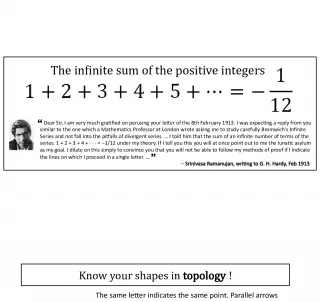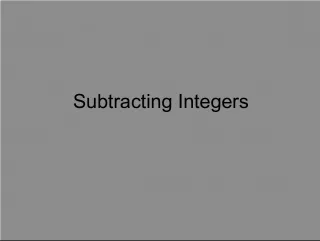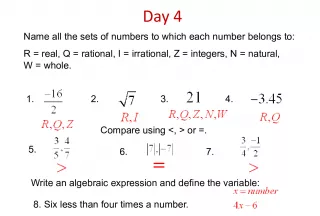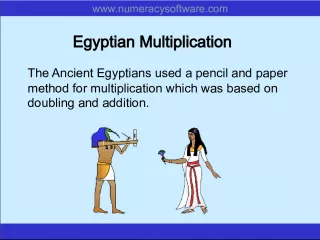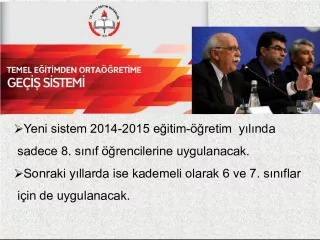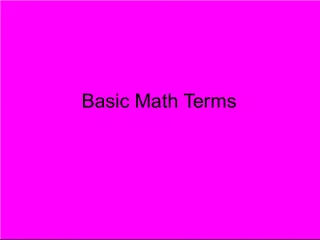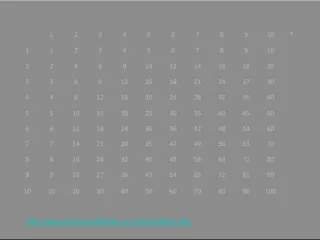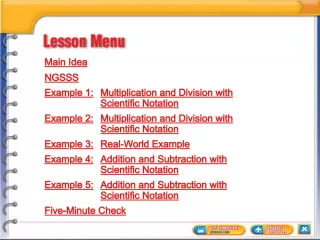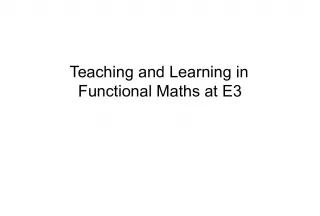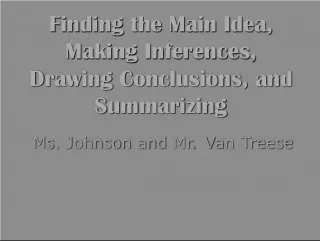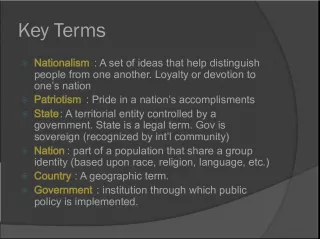Understanding Integers and Addition


Explore the set of whole numbers and their opposites, learn about zero pairs and pictorial models. Understand the rules for adding integers and the concept of additive inverse.
- Uploaded on | 1 Views
-
 sarahjacobs
sarahjacobs
About Understanding Integers and Addition
PowerPoint presentation about 'Understanding Integers and Addition'. This presentation describes the topic on Explore the set of whole numbers and their opposites, learn about zero pairs and pictorial models. Understand the rules for adding integers and the concept of additive inverse.. The key topics included in this slideshow are . Download this presentation absolutely free.
Presentation Transcript
1. Integers: The set of whole numbers and their opposites {. . .-2, -1, 0, 1, 2. . .}. Zero Pairs: The result of a positive counter paired with a negative counter. Ex: Pictorial Models: Visual representation as by photography or painting. Ex: -5 -4 -3 -2 -1 0 1 2 3 4 5 4 + ( -7 )= -3 Unit 2 vocabulary
2. Adding Integers: When adding two positive integers the answer will always be positive. When adding two negative integers the answer will always be negative . When adding a positive and a negative integers the answer will keep the the sign of the larger number Sum: The addend is one of the numbers that is being added in order to find a sum. Additive inverse: A number that when added to a given number, results in a sum of zero. Example: The additive inverse of 4 is -4 because 4 + (-4) = 0.
3. Subtracting Integers: When subtracting positive integers the answer will be positive. When subtracting negative integers the answer will depend on the larger number Ex: -3-4=-7 or -3-(-4)=1 . When two negative signs are side by side they will change to a positive sign. . Difference: The difference is the answer in a subtraction problem. Example: 4 Minuend -1 Subtrahend 3 Difference
4. Multiplying Integers: When multiplying integers follow the rules of: + x + = + - X - = - + x - = - Factor: The factor of a number is a number that divides that number exactly. For example, the factors of 6 are 1, 2, 3 and 6. Product: The product is the answer in a multiplication problem. Example: 5 Multiplicand x 2 Multiplier 10 Product
5. Dividing integers: When dividing integers the same rules apply as multiplication. + x + = + - x - = - and + x - = - Divisor: is the number that the dividend is divided by (in long division ). Example: 6 ÷ 2 = 3 Dividend: is the number that is divided (in long division ). The dividend divided by the divisor is the quotient . Example: 6 ÷ 2 = 3 Quotient: is the answer in long division . The dividend divided by the divisor is the quotient . Example: 6 ÷ 2 = 3
6. Coordinate Plane: A plane, also called a coordinate grid or coordinate system, in which a horizontal number line and a vertical number line intersect at their zero points. X-Axis: The horizontal line on a coordinate plane. Y-Axis: The Vertical line on a Coordinate Plane Quadrant: A quadrant is a quarter of a plane . The x-axis and y-axis divide the x-y plane into four quadrants. The axes themselves are not part of the quadrants.
7. Ordered Pair: A pair of numbers used to locate a point in the coordinate plane or the solution of an equation in two variables. An ordered pair is written in the form: Ex. (3,2) ( x -coordinate, y -coordinate). Coordinates: are an ordered pair of numbers that show the location of a point on the x-y plane. Every point on the plane can be located by a pair of coordinates (x,y), which notes its distance from the x-axis and the y-axis . Respectively: in the order given Concrete: capable of being perceived by the senses; not abstract or imaginary; "concrete objects such as trees"
8. Line segment: the part of a line that is between two endpoints. Ex. ._________________. Endpoint: the point at the beginning and end of a line segment Ex. ._______________ . Midpoint: On a line segment, the point that is halfway between the endpoints. Ex. ._________._________.

